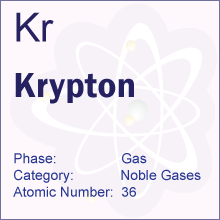 Periodic Table -> Krypton
Periodic Table -> KryptonKrypton
Krypton DetailsKrypton Symbol: Kr
Krypton Atomic Number: 36
Krypton Atomic Weight: 83.80
What is Krypton?
Krypton (atomic number 36, symbol Kr) is a chemical element and a tasteless, odorless, and colorless noble gas, which is inert. It is characterized by several spectral signatures or sharp emission lines, and the strongest of them are yellow and green.
Krypton has 30 isomers and unstable isotopes and 6 stable isotopes. One of them, Kr-81 occurs with other isotopes of the element and is created as a result of atmospheric reactions. Due to its radioactivity, the half-life of krypton-81 is 230,000 years. It has application in dating old ground water, but near surface water, the isotope is highly volatile.
The element was discovered by Morris Travers and Sir William Ramsay in 1898 in Britain. The chemists discovered neon a couple of weeks later, and Ramsey received the Noble Prize in Chemistry in 1904 for the discovery of krypton and other noble gases.
Given the high costs of obtaining the element, krypton does not have many practical applications. One is in high speed photography, and krypton is used in some kinds of photographic flashes. A mixture of argon and krypton is used to fill some types of fluorescent light bulbs. In combination with other gases, krypton is used to create luminous signs with yellow-greenish light. One important application of krypton is in the usage and production of fluoride laser, which is used in confinement experiments related to nuclear fusion energy. The laser modifies spot size, has short wavelength and high beam uniformity, which makes it possible to track imploding pellets.
A mixture of unstable and stable isotopes of the element is used to slow uraniumís neutron fission. The most stable isotope of krypton, krypton-85 helps detect leakage in sealed containers. Abnormal heart openings are detected using krypton-85 as well. In the absence of sources of energy, the isotope is used to excite phosphors in a light source. Krypton-83, another isotope of the element, is used for imaging airways in MRI (magnetic resonance imaging). More specifically, krypton-83 is issued to differentiate between hydrophilic and hydrophobic surfaces that contain an airway. In addition, xenon can be used to assess ventilation in computed tomography.

Notably, this element is among the rarest gases found in the earthís atmosphere. At the same time, while there are over 15 billion tonnes of krypton out there, just 8 tonnes of those circulating are extracted. Extraction of krypton can take place through fractional distillation. According to some, the amount of krypton existing in space is not certain, because it is derived from solar winds and meteoric activity. Preliminary measurements have suggested that the element is abundant in space.
Krypton is classified as an inert gas, and it is a simple asphyxiant. In case excessive amounts are inhaled, this can cause vomiting, nausea, dizziness, loss of consciousness, and even death. Death is usually the result of loss of consciousness, confusion, and errors in judgment, preventing self-rescue. Death and loss of consciousness occur without warning and in seconds at low concentrations of oxygen. The first symptoms are air hunger and rapid respiration, impaired muscular coordination and diminished mental alertness. Fatigue occurs quickly due to emotional instability, followed by convulsions, comma, and ultimately death. With regards to environmental effects, the element is chemically inert and non-toxic. At extremely cold temperatures, it freezes organisms, but no long-term effects are expected.
You can
link to this page, using the code below:
Periodic Table |
Banks
© ElementsDatabase.com 2015 | Privacy | About | Contact